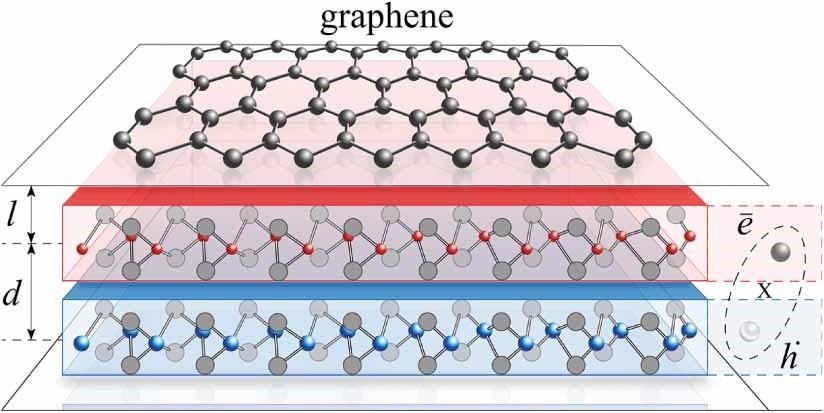In superconductivity, a physical phenomenon, the electrical resistance of a material falls to zero under a specific critical temperature.
 A hybrid system consisting of an electron gas in graphene (top layer) separated from a two-dimensional Bose-Einstein condensate, represented by indirect excitons (blue and red layers). The electrons in the graphene and the excitons are coupled by the Coulomb force. Image Credit: Institute for Basic Science.
A hybrid system consisting of an electron gas in graphene (top layer) separated from a two-dimensional Bose-Einstein condensate, represented by indirect excitons (blue and red layers). The electrons in the graphene and the excitons are coupled by the Coulomb force. Image Credit: Institute for Basic Science.
Superconductivity in a majority of the materials is described by a well-established explanation - the Bardeen-Cooper-Schrieffer (BCS) theory. According to this theory, Cooper pairs of electrons form in the lattice under adequately low temperature and BCS superconductivity emerges from their condensation.
Graphene is considered to be an excellent conductor of electricity and does not display BCS superconductivity because electron-phonon interactions are suppressed in this material. This is why a majority of the “good” conductors like copper and gold tend to be “bad” superconductors.
Scientists at the Center for Theoretical Physics of Complex Systems (PCS), within the Institute for Basic Science (IBS, South Korea) have come up with an innovative alternative mechanism to realize superconductivity in graphene.
This was made possible through a hybrid system comprising graphene and 2D Bose-Einstein condensate (BEC). This study was published in the 2D Materials journal.
BEC is another phenomenon that occurs at low temperatures and is similar to superconductivity. It is the fifth state of matter first proposed by Einstein in 1924. BEC forms when low-energy atoms group together and reach the same energy state. It is an extensively studied area of research in condensed matter physics.
A hybrid Bose-Fermi system is typically a layer of electrons that interacts with a layer of bosons, like exciton-polaritons, indirect excitons, etc. The interaction between Bose and Fermi particles results in several novel phenomena, which gain attention from both the basic and application-oriented points of view.
The researchers of this study describe a new mechanism of superconductivity in graphene that occurs as a result of the interactions between electrons and “bogolons,” instead of phonons as in standard BCS systems. Bogolons, also called Bogoliubov quasiparticles, are excitations that occur within BEC, which exhibits a few properties of a particle.
In some parameter ranges, this mechanism enables the critical temperature for superconductivity of up to 70 K inside graphene. Moreover, the team formulated a new microscopic BCS theory that particularly concentrates on the novel hybrid graphene-based system.
The suggested model proposes that superconducting properties can be improved with temperature, leading to the non-monotonous temperature dependence of the superconducting gap.
The study also demonstrated that in this bogolon-mediated scheme, the Dirac dispersion of graphene is maintained. That is, this superconducting mechanism involves electrons with relativistic dispersion — a phenomenon not very well-examined in the condensed matter physics.
This work sheds light on an alternative way to achieve high-temperature superconductivity. Meanwhile, by controlling the properties of a condensate, we can tune the superconductivity of graphene. This suggests another channel to control the superconductor devices in the future.
Ivan Savenko, Leader of the Light-Matter Interaction in Nanostructures Team, Theoretical Physics of Complex Systems, The Institute for Basic Science
Journal Reference:
Sun, M., et al. (2021) Bose–Einstein condensate-mediated superconductivity in graphene. 2D Materials. doi.org/10.1088/2053-1583/ac0b49.